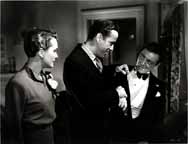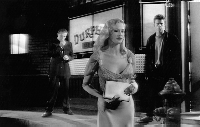FILM NOTES
FILM NOTES INDEX
NYS WRITERS INSTITUTE
HOME PAGE

The Maltese Falcon and Exterior Night
THE MALTESE FALCON
(American, 1941, 101 minutes, b/w, 35 mm)
Directed by John Huston
Cast:
Humphrey Bogart . . . . . Sam Spade
Mary Astor . . . . . Brigid O'Shaughnessy
Peter Lorre . . . . .Joel Cairo
Sidney Greenstreet . . . . .Kasper Gutman the Fat Man
When John Huston began his push to make Dashiell Hammett’s novel, The Maltese Falcon, into his first film as a director, he had to be reminded that Warner Brother’s had already made THE MALTESE FALCON. Twice, in fact. In 1931, a plodding but faithful adaptation starred Ricardo Cortez as Sam Spade, who played the detective as a leering ladies’ man. Warner’s had tried again in 1936, this time battering Hammett’s bleak, hard-boiled masterpiece into a combination mystery-screwball comedy, called SATAN MET A LADY, starring Bette Davis. The trouble, said Huston, was that previous screenwriters had kept trying to ‘lick the book,’ instead of filming the book. Huston, a screenwriter since 1931, set out to make The Maltese Falcon surrender its deeply existential essence.
What appealed to Huston in The Maltese Falcon was the complex predicament of its protagonist, detective Sam Spade. Like other readers, he had noticed a stunningly allegorical passage in the book, told in Spade’s voice, about a fugitive he had once had to search for, a strange little man named "Flitcraft." Flitcraft had been walking by a construction site when a heavy beam had fallen near him, almost killing him, but leaving him unscathed. The casualness of human existence had been demonstrated forcefully to Flitcraft: "somebody had taken the lid off life and let him look at the works. . . Life could be ended for him at random by a falling beam; he would change his life at random by simply going away. . ." Heretofore a respectable family man, Flitcraft changed his identity, moved to another city, and married another woman, all with apparent ease: "He adjusted himself to beams falling, and then no more of them fell, and he adjusted himself to them not falling." The mystery of life was in its very living, not in the loot, Spade recognized in his talk with Flitcraft, and so apparently did Huston, for, ever after, Huston’s films would begin with a grandiose scheme and end with empty hands.
 THE MALTESE FALCON’s famous epitaph -- "the stuff that dreams are made of" -- is meant as Spade’s weary pronouncement on the glorious futility of ever really finding what it was that the Falcon had come to embody to its pursuers. The line was Huston’s own invention, and it might well have served as his epitaph as a director for the next 45 years.
THE MALTESE FALCON’s famous epitaph -- "the stuff that dreams are made of" -- is meant as Spade’s weary pronouncement on the glorious futility of ever really finding what it was that the Falcon had come to embody to its pursuers. The line was Huston’s own invention, and it might well have served as his epitaph as a director for the next 45 years.
Huston seized on the sheer fabulousness of the gilded bird of the title, a virtual throwaway in the book. He made its journeys through centuries and across continents a wild offscreen picaresque, a spider’s web of intrigue from out of the near as well as the distant past that always threatens to snare Spade just as it has snared the three demented conspirators. These three -- "Gutman" (Sidney Greenstreet) "Miss Wonderly/O’Shaughnessy" (Mary Astor) and "Joel Cairo" (Peter Lorre) became, in Huston’s hands, lovable gargoyles, creatures as improbable as the Falcon, and each as corroded with greed as the once-shimmering Falcon is coated with cheap enamel.
The studio’s boss, Jack L. Warner, was, to be charitable, a literalist, and the tale of the Falcon’s passage from Malta to San Francisco quickly lost him. He insisted that Huston invent additional dialogue for Gutman, and write an introductory title crawl, both of which would "clarify" the Falcon’s lineage. Huston gleefully obliged. The result was the film’s wacky "Tinker-to-Evers-to-Chance" backstory of the Falcon’s progress; the only thing this new material "clarifies" is Huston’s love of a good story at any cost.
In Bogart’s unique portrayal of Sam Spade, Huston artfully constructed a tough, sexy, smart and self-assured man who is confronted with a plot whose intricacies tax even his powers of reason, as well as his bravery, a caper whose villains would lie him into bed, into the grave, or both. Yet his adversaries’ maniacal obsession with the "dingus" makes Spade even more determined to puzzle out its whereabouts. The result is a conflict as biting and real as it is witty and exasperating, and the ‘Huston touch,’ so deft that most film scholars have overlooked it, was born. It would remain intact until Huston’s passing in l987 and his last, deathbed words to his daughter Angelica: "Give ‘em hell."
As he reengineered the source material for THE MALTESE FALCON, Huston pared away unnecessary characters and limited action to a few locations: Sam’s office, Miss O’Shaughnessy’s hotel room, Gutman’s suite, Sam’s apartment, a few others. The idea was to make Sam’s world a rat’s maze; constricted, frustrating, exhausting. . . In the process, Huston went about inventing what we now call film noir, showing other directors that in the urban crime drama, tight, claustrophobic spaces are as psychologically significant and as thematically profound as spacious outdoor vistas are to the Western. Again, Warner intervened, this time with less happy results. It was he who added the abrupt exterior shot of Miles Archer’s shooting, with the identity of the shooter coyly withheld by subjective camerawork. It’s a cheap, "detective movie" trick, unworthy of Huston, the only moment of ventilation in a film that otherwise feels like it has purposely locked itself up in a hothouse. One of Huston’s competitors on the Warner’s lot, director Jean Negulesco, later claimed that he had "prepared" THE MALTESE FALCON, and that, when he had been furloughed from the project to do a government short, Huston had been given the plum assignment. Out of gratitude, said Negulesco, Huston later gave him a copy of Eric Ambler’s espionage thriller A Coffin for Dimitrios, which Negulesco subsequently made into a creepy, perverse film called THE MASK OF DIMITRIOS, about a man as mysterious and dangerous as the Falcon, a film very much in the Huston vein. Later, Huston wrote the script of the sardonic THREE STRANGERS for Negulesco, another variation on the FALCON’s "three conspirators" motif, a group that included both Sidney Greenstreet and Peter Lorre. But THE MALTESE FALCON was all Huston. It is, with CITIZEN KANE, the most significant first film in Hollywood history, a rare example of an instantly mature cinematic style.
Huston’s debts to his own brilliant debut film remained clear throughout his working life. In films such as THE TREASURE OF THE SIERRA MADRE, THE ASPHALT JUNGLE, BEAT THE DEVIL, and THE MAN WHO WOULD BE KING, Huston retained his affection for hopeless little conspiracies, often undertaken by groups of three, echoing Gutman, Miss O’Shaughnessy, and Joel Cairo in THE MALTESE FALCON. Because of his microscopic attention to the mechanics of heists and scams and the structures of the gangs that pulled them, as well as his disinterest in moralizing on the place of the criminal in his society, no less a critic than James Agee called Huston "the Eisenstein of the thriller."
Huston never shared the poverty of ethics of the three crazed Falcon hunters. Instead, after finishing THE MALTESE FALCON, he was to see first-hand a world in flames, a suddenly absurd and deadly world that seemed to push everyone with a brain and a conscience into the same tight corners and closed rooms as Sam Spade. Huston’s horrific wartime documentaries THE BATTLE OF SAN PIETRO and LET THERE BE LIGHT, with their rare combination of exquisite sarcasm and deep humanity, made it seem as if in Sam Spade, Huston had been quietly inventing an epic hero perfectly designed for his own time.
EXTERIOR NIGHT
(German, 1994, 36 minutes, color, 35 mm)
Directed and written by Mark Rappaport
Cast:
Johnny Mez. . . . . Steve
Victoria Bastel. . . . . Mona/Sylvie/Mom
David Patrick Kelly. . . . . Biff
Mark Arnott. . . . . Dad
Although so great a film as THE MALTESE FALCON doesn’t really need a mood enhancer, the film noir homage, EXTERIOR NIGHT, acts as such. Mark Rappaport seems to have written his script for EXTERIOR NIGHT from the list at left, with an odd dash of BACK TO THE FUTURE thrown in.
 Skillfully using actual black-and-white exterior night backdrop footage from THE MALTESE FALCON, THE BIG SLEEP, MILDRED PIERCE, DOUBLE INDEMNITY, and THE POSTMAN ALWAYS RINGS TWICE, and maybe not so skillfully using film noir plotting, Rappaport lays out a rather convoluted tale of a young man in red sneakers (all of Rappaport’s story characters appear in color), who probes dimestore detective novels and his own family background to find his gumshoe roots. The result in this video-based film would be contemporary kitsch were the film not so earnest in its attempts to come full circle. One brilliant technique Rappaport uses, almost as a hallmark in his work (he’s made a number of short films), is to have one on-screen character mouth what was begun as another character’s voiceover narration. It gives a lilt to the presentation reminiscent of Truffaut’s great homage to film noir, SHOOT THE PIANO PLAYER.
Skillfully using actual black-and-white exterior night backdrop footage from THE MALTESE FALCON, THE BIG SLEEP, MILDRED PIERCE, DOUBLE INDEMNITY, and THE POSTMAN ALWAYS RINGS TWICE, and maybe not so skillfully using film noir plotting, Rappaport lays out a rather convoluted tale of a young man in red sneakers (all of Rappaport’s story characters appear in color), who probes dimestore detective novels and his own family background to find his gumshoe roots. The result in this video-based film would be contemporary kitsch were the film not so earnest in its attempts to come full circle. One brilliant technique Rappaport uses, almost as a hallmark in his work (he’s made a number of short films), is to have one on-screen character mouth what was begun as another character’s voiceover narration. It gives a lilt to the presentation reminiscent of Truffaut’s great homage to film noir, SHOOT THE PIANO PLAYER.
See if you can pinpoint which backdrops come from THE MALTESE FALCON.
— Kevin Hagopian, Penn State University
For additional information, contact the Writers Institute at 518-442-5620 or online at https://www.albany.edu/writers-inst.